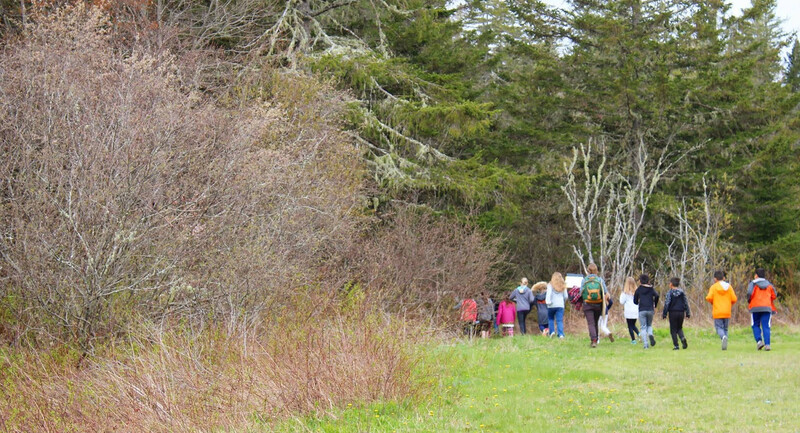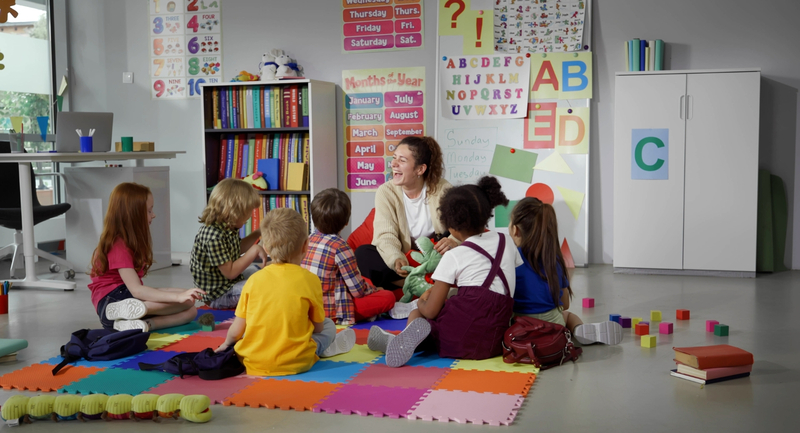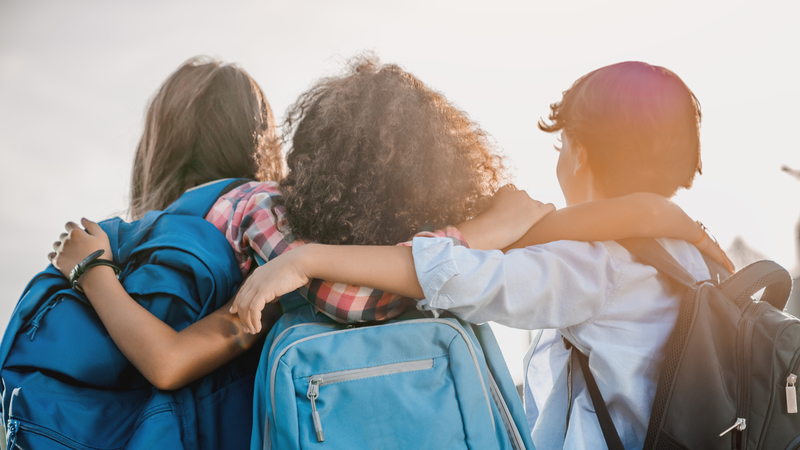Good morning, Kindergarten!" Mrs. Kelly says to her arriving students. "Today is Elliot's Someday, and he wants more than anything to go outside and look at the sky. What do you think we will see?"
The children gather around Elliot, offering high fives and hugs. The fleece blankets they'll take with them to lie on as they gaze at the sky are stacked neatly on the teacher's desk, along with a canvas bag filled with water and snacks. "So," Mrs. Kelly explains, "we have a whole morning planned in honor of Elliot's Someday wish. We'll read It Looked Like Spilt Milk and talk about clouds. We'll even draw our own clouds with white crayons on blue construction paper."
When it is time to go outside, Elliot—a small boy with a crooked, mischievous smile whose mother has struggled to find secure housing in an unstable rural rental market—can hardly contain himself. This practice of "Somedays" in his school invites all students and teachers to share their wish for a special activity. It is one of several strategies at the core of the all-school approach that we as educational researchers designed and piloted in partnership with several rural elementary schools. Working closely with three Maine schools between 2017 and 2021, and replicating successful practices with other schools in Maine and California, we brought together the best of what we know about creating and sustaining healthy developmental ecologies for children and youth in socio-economically and racially diverse rural elementary schools.
Our experience suggests that students themselves have a key role to play in helping educators create school environments that nurture well-being. We scaffolded schoolwide shifts in how teachers understand and work with children, infused schools with student-initiated activities, and created the necessary conditions for young people to participate in their own healing.
Listening with Care
In The Vulnerable Heart of Literacy, Elizabeth Dutro (2019) says that the word trauma is both ubiquitous in its use these days and highly ambiguous. Healing, she says, requires both a critical lens—the "necessary work of questioning what is meant by the term trauma"—and a kind of tenderness, openness, and flexibility that unsettles traditional schooling (p. 4). Becoming a trauma-responsive school, then, is not an easy or straightforward task. Developing genuine, trusting relationships and creating opportunities for voice and empowerment are often in contrast with teacher authority and school rules designed to maintain control and move things along in orderly fashion (Deci & Ryan, 2000; National Scientific Council on the Developing Child, 2015). This is especially true when those teaching and learning are under the kind of stress we've seen during the pandemic.
Every day for the rest of the year, the coach and a team of educators in each school did their very best to make those wishes come true.
Over the past five years, our team of researchers and practitioners at the Rural Vitality Lab piloted and refined schoolwide strategies for fostering student voice and empowerment in schools to promote mental health, well-being, and emotional healing. Our approach is grounded on the assumption that trauma-responsive school culture is best achieved in genuine relationships with children. This requires that we listen to students and trust them as experts on their own experience and that we engage them as full and active partners in school and community transformation. If promoting agency, control, and empowerment is critical to addressing and mitigating adversity, stress, and trauma, our job is to create opportunities for student voice, engagement, and meaningful participation (van der Kolk, 2014).
A focus on equity was foundational to our work—our goal was to ensure that all students in our three initial rural Maine partner schools had access to the same opportunities such as food, transportation, and mental health support. This included setting up food pantries, providing coat and boot closets, and expanding in-school mental health services. A school-based coach trained in our approach then worked in partnership with teachers and school staff to develop a shared understanding of the role that voice and empowerment play in trauma-responsive schooling. We initiated a set of whole-school practices designed to engage children around pressing and meaningful aspects of their lives, provide opportunities for students to express and access what they love and want from school, and allow them to speak about and explore what feels unfair or impedes their education and growth.
Starting with Somedays
We began with the low-effort, high-impact activity that we call Somedays, adapted from our partnership with the Center for School Climate and Learning (Preble & Gordon, 2011). Like Elliot, every student and teacher in our partner schools completed this sentence: "Someday in school, I would like to ___." And then, each day for the rest of the year, the coach and a team of educators in each school did their very best to make those wishes come true.
Everyone involved was surprised by how modest and achievable the changes students asked for could be. A 4th grader asked to have recess with her 2nd grade cousin, whose lunch schedule was different from hers. A 3rd grader wanted every student to start the new quarter with a 100 already in the grade book so they could each feel successful for one day. Another wanted to have his mother read a book in Spanish while he translated for the class. Teachers were able to join in, too: One asked for a compliment day where people left nice notes for one another. Another wished to leave school a bit early one day to meet her son at the bus stop.
When a student asked to bring in her pet (which wasn't possible), her Someday became an opportunity for everyone in the school to bring in a photo of a pet or an animal they loved. Pictures of dogs, cats, bunnies—even chickens—covered a huge bulletin board in the hallway that became a popular destination for students, parents, and teachers.
The response to Somedays had a surprisingly profound impact on the development and trajectory of our work. Teachers' perspectives of children changed, relationships deepened, and families reappraised the social boundaries between home and school. "What I like about Somedays is that you can trust that yours will come true," a 5th grade girl told us. "Let's say you don't really like a teacher and you don't really trust them, and then they make your Someday come true—and it's like, I can sort of trust these people." A mother of three children said, "Our school has always been a homey place. Now it feels more … it's more electrified."
Moving Toward Microadventures
In addition to Somedays, we piloted a related initiative called "Microadventures." When we asked students about the kind of changes to their schools they would like to make, we heard over and over again: More outdoor time, more recess, more movement. Together with students and teachers, we brainstormed ways to incorporate movement and outdoor time into the school day.
In outdoor education vernacular, microadventures are small, low-cost, easy-to-run expeditions. We joined with a local outdoor school to adapt this idea and build it into the curriculum through "Wilderness Wednesdays" or "Forest Fridays" (Brown & Flaumenhaft, 2019). Through these initiatives, students engaged in outdoor learning by designing and building shelters using mathematical concepts, identifying local flora and fauna found near the school, and writing creative responses to their experiences in the outdoors. Most important, students experienced multiple opportunities for cooperative, full-body learning that had them engaging in new ways with peers and their teachers.
Student-initiated Somedays increasingly became the impetus for microadventures that showcased children's interests, surprising skills, and underappreciated knowledge and capabilities. As a parent of a 3rd grade boy explained:
He has trouble at school just staying focused on basic things, and he gets very frustrated. And like he just shuts down. … He liked the day that they built the shelters. He said that was awesome. The teachers are like, "We just can't get over how this kid can be such a leader outside of the classroom, where in the classroom he's quiet and reserved and not sure of himself." But he's an outdoor boy. Yeah … I feel like sometimes he's untapped on the potential that he has.
Microadventures ensure equitable access to opportunities and resources that meet basic psychological needs (Deci & Ryan, 2000). Having autonomy, feeling competent, and being connected to others are keys to thriving and well-being, but these experiences are more accessible to some students than to others. As one principal explained, initiating and taking part in outdoor learning "makes students feel wanted and whole, involved in something bigger than themselves." She links happiness to the capacity for every student "to access their learning lives at school and be the kind of students or people they want to be. Kids are learning more about themselves. That's trust. They are learning to trust that they're going to be taken care of and that they can take care of themselves even better."
Somedays and microadventures are both examples of what we call student empowered social emotional learning (SESEL). Traditional approaches to social-emotional learning (SEL) often use standardized curricular materials to promote the development of personal and relational competencies and skills that students are assumed to lack. Such SEL curricula tend to be teacher-centered and, in some cases, even used as behavioral management or disciplinary tools. SESEL, in contrast, encompasses practices that affirm what students bring to the classroom by encouraging students to identify and choose activities they love or value, to experience what it feels like to positively engage with and positively influence others, and in many cases, to share their expertise with classmates and teachers. These practices offer students a too-infrequent sense of control over their learning, connectedness to others, and a sense that they matter in their school environment (Brown, Biddle, & Tappan, 2022).
When we asked students about the kind of changes to their schools they would like to make, we heard over and over again: More outdoor time, more recess, more movement.
Empowering Students to Lead
Teachers cannot always know what challenges their students bring to school, but they can work to develop healthier school ecologies by creating opportunities for children to voice their needs and embrace their strengths. In one of our partner schools, the entire 6th grade—the oldest children in the school—took on a leadership role to improve the school's climate. With adult scaffolding, the student leadership team distributed climate surveys to other students and staff and helped younger children fill out their forms. Once the results were tabulated, the team set three schoolwide goals for the coming year: (1) make the school feel safer; (2) connect learning to student interests, talents, and strengths, and (3) include student voice in school decision making and offer more opportunities for students to work with, talk with, and learn from teachers and other students. As one of the teachers explained after seeing the survey results and hearing the students' presentation, "I didn't realize until the surveys came out—they think everything is done to them. They don't have a say in things. What we're giving them for choices really aren't choices."
Throughout the school year, the 6th graders worked to put their plans in place. During Monday morning assemblies, they encouraged younger students to support one another, to stand up for each other, to treat one another with kindness. They acknowledged the stress of school, sharing relaxation tips that worked for them before and during tests and educating their fellow students about mindfulness practices. They created public art projects that made issues of difference and diversity a more visible and valued part of the school experience. They took on the role of supporting marginalized students, actively responding to experiences of unfairness and hurt. In the process, they made their own developmental gains. As an example of SESEL, students articulated what they cared about and valued, they engaged with issues and situations relevant to their lives, and they worked through differences and found commonalities.
The Link Between Voice and Well-Being
Listening to students' voices reminds us that children and youth are multifaceted, that developmental progress is multidimensional (Cantor et al., 2021). To understand children's needs, particularly children who because of systemic injustice and inequity experience school on the margins, we must create spaces and opportunities for them to speak about their experiences, to explain what isn't working, to ask for what they need, and to share what excites them and nurtures them. Doing so makes for good educational practice. Several important outcomes resulted from these and other opportunities for students to voice their interests, desires, and concerns: By the second year of our five-year project, academic achievement increased, chronic absenteeism decreased, and school climate improved in all three of the Maine schools we worked with. Students reported at much higher rates that they felt listened to by the adults around them, that they felt safe, and that they mattered.
A child's sense of safety, or their readiness to learn, is not entirely within our control. We need to remain open to what children tell us they know, to believe in their capacity to be experts on their own experience, and to be willing not only, as researcher and sociologist Jessica Taft says, "to imagine childhood otherwise" (2019, p. x), but to reshape our practices and policies to account for such reimagination. By doing so, children can impact the way things usually go in schools and recreate their school ecology so that it reflects them, works for them, and contributes to their well-being.
Reflect and Discuss
➛ What are some simple, fun, but effective ways to empower students in your school to be decision makers?
➛ In what ways are students taking on leadership roles at your school? How can you create more space for this?
➛ What would your "Someday" wish be?








